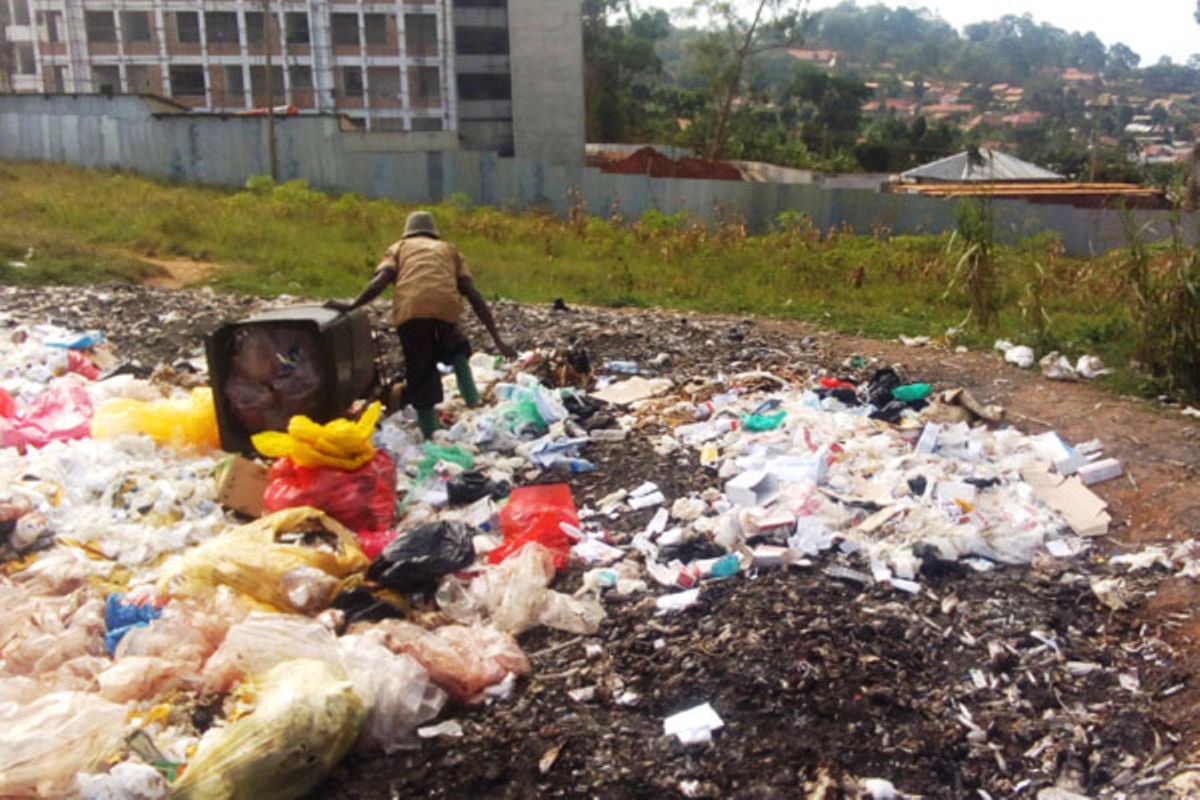
As she gets out of her house, 30-year-old Annet Nabbada finds her child holding a piece of stained cotton wool.
“Dirty, dirty! Put it down, these dogs have again carried hospital waste from the dumping site to our compound,” she exclaims as she runs towards the child.
Nabbada curses Masaka Regional Referral Hospital administration for reckless dumping of its medical waste near residences and taking long to incinerate it, resulting in choking stench.
Her neighbour Shamira Nakagwa says they have to keep a keen eye on their children who often loiter around the dumping site, picking infectious waste such as syringes, which expose them to injury.
Before the two mothers conclude their narrative, an old man comes dragging a big waste bin, walks through burnt waste mostly syringes.
Standing in the middle of the pit, bare-handed, he starts emptying the bin of soiled cotton wools and other forms of infectious waste. He picks a can of fuel and burns the waste.
However, the residents say the burning worsens the situation as the resultant toxic emissions hang in the air and cause respiratory complications.
“We do not know what happened because they used to use an incinerator. They now dump and burn waste in an open shallow pit,” a female resident who preferred anonymity lamented.
The duo stays in the backyard about 30 metres away from where the hospital dumps and burns its medical waste.
A similar ordeal is echoed by residents near Lyantonde General Hospital in Lyantonde District.
“The stench from the site where the hospital drops its waste before it is taken is unbearable. It covers the entire place and at worst scenarios, the flies from it get into contact with our household utensils,” says Mr John Kaweesi, a resident of Lyantonde Town.
He says their efforts to seek help from the municipal authorities have been fruitless.
The Ministry of Health classifies this waste as: Highly infectious waste such as amputated limbs, placenta, extracted teeth, used test tubes and test kits, used blood bags, and food items from highly infectious patients.
Infectious waste: It includes used gauze, used cotton, pads and clothes, and contaminated bottles for infusion fluids.
Sharps: These are used syringes, needles cut off infusion sets, used scalpels, broken glass, ampoules, and cannulas.
Pharmaceutical waste: These include expired and damaged drugs, lab reagents, empty vials and heavy metals.
Non-infectious waste: These contain food items, empty bottles for drinks, paper, and packaging material.
In Uganda, infectious and non-infectious waste generated in hospitals averages 92kg and 42kg at Health Centre IVs level daily. Health Centre IIs and IIIs generate about 20kg to 25kg of waste.
According to WHO, 15 per cent of medical waste is harmful material and infectious. Such waste requires safe disposal to prevent health care workers, waste handlers, patients and communities in the vicinity of the respective health facilities from risks of nosocomial infections and other hazards.
Nosocomial infections are health care related and acquired from health facilities due to breaches of infection control practices for proper waste disposal.
In Uganda, many hospitals burn infectious waste in shallow open pits, which generates toxic emissions that affect people’s health. This is contrary to the recommended use of incinerators, an ideal method for disposal of such waste.
An incinerator is an apparatus used for burning waste material, especially industrial waste, at high temperatures until it is reduced to ash.
Mr Peter Waiswa, an associate professor at Makerere School of Public Health, explained that incineration renders infectious medical waste harmless and reduces the waste mass and volume by more than 90 per cent.
However, many public and private hospitals in Uganda lack incinerators, but even in a few health facilities where government has installed them, many of them are defective and cannot do the job.
At Masaka Regional Referral Hospital, a modern incinerator that was installed in 2013 to end many years of poor waste disposal, is dysfunctional. It has turned into a shed for goats and other domestic animals.
The hospital infectious waste is burnt in an open pit.
Mr Edward Kabuye, the hospital principal administrator, said they shunned the incinerator because it is defective.
“We resorted to open burning of infectious waste using diesel because the incinerator could not burn waste to the required temperatures,” Mr Kabuye noted.
However, he said the challenge of waste disposal will soon be settled when the hospital secures an investment partner.
“Rakai Health Science programme is going to build for us a good incinerator. They have already built one for Kalisizo Hospital in Kyotera District and it is doing well,” said Mr Kabuye.
During a visit to Nakaseke Hospital recently in Nakaseke, the parliamentary committee on Health was shocked to learn that the hospital has had no incinerator for 30 years.
Mr David Ssemakula, the hospital administrator, told the MPs that government supplied an incinerator but it had never worked.
We have since been using a private company to dispose of medical waste, but the contract expired recently and we resorted to open burning,” he told the legislators.
Similarly, Lyantonde General Hospital, in Lyantonde District, had a modern incinerator but it was abandoned for similar reasons.
